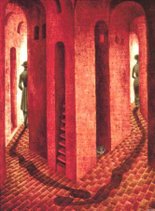 February 6th is the Sámi National Day. The first Sámi congress was held on February 6th, 1917 in Trondheim, Norway.
February 6th is the Sámi National Day. The first Sámi congress was held on February 6th, 1917 in Trondheim, Norway.It is estimated that the number of Sámis is between 60,000 and 70,000: approximately
40,000 in Norway; 20,000 in Sweden; 7,500 in Finland and 2,000 in Russia.
The word Sámi (sometimes Saami) is the one used now to talk about them. In the past, they were identified by several derogative names: lapper (Lapps) or finner (Finns) in Norway; in Sweden, lappar (Lapps); and lappalaiset (Lapps) in Finland.
Sápmi is the name of the traditional homeland of the Sámi. The term is found in all Sámi
dialects. It derives from the Sámis’ own name for themselves, sámit or sápmelaččat.
 There is no single Sámi language. All they form a family of eleven members: Southern Sámi, Ume Sámi, Pite Sámi, Lule Sámi, Norther Sámi (these are the Western Sámi languages) and Inari Sámi, Kemi Sámi, Skolt Sámi, Akkala Sámi, Kildin Sámi and Ter Sámi (these are the Eastern Sámi languages).
There is no single Sámi language. All they form a family of eleven members: Southern Sámi, Ume Sámi, Pite Sámi, Lule Sámi, Norther Sámi (these are the Western Sámi languages) and Inari Sámi, Kemi Sámi, Skolt Sámi, Akkala Sámi, Kildin Sámi and Ter Sámi (these are the Eastern Sámi languages).The Sámi language is rich in words and expressions describing nature, fauna, formations in
nature and snow; terms that are important in hunting, fishing and reindeer herding societies.
The changes in the Sámi lifestyle have resulted in loss of many particular terms and
expressions which are no longer relevant or in use today.
Not all Sámis speak their language nowadays. Kemi Sámi and Akkala Sámi are extinct. Southern Sámi seems to be the next on the list, as it is no longer the everyday language in many South Sámi families (it is estimated that only 300 speakers are left).
All Sámi languages use an extended version of the Latin alphabet. Depending on the language, these are the special characters (of course, not a single language uses all of them!): á, â, ä, č, ʒ, ǯ, đ, ǧ, ǥ, ǩ, ŋ, ń, õ, š, ŧ, ž, æ, å, ï, ø. Some of these letters are also present in Icelandic, Norwegian, Swedish and Faroese. Kildin Sámi is the only one of them that uses an extended version of the Cyrillic alphabet. The extra letters are: ä, ӣ, ӆ, ӎ, ӊ, ӈ, ҏ, ҍ, (note that these ones are different from й, л, м, н, р and ь), ӭ, j and ѣ, and it makes use of macrons.
Article 110a of the Kongeriget Norges Grunlov, the Norwegian constitution states:
Det paaligger Statens Myndigheder at lægge Forholdene til Rette for at den samiske Folkegruppe kan sikre og udvikle sit Sprog, sin Kultur og sit Samfundsliv.That is:
It is the responsibility of the authorities of the State to create conditions enabling the Sámi people to preserve and develop its language, culture and way of life.Sámi is an official language of the municipalities of Kautokeino, Karasjok, Kåfjord, Nesseby, Porsanger, Tana, Tysfjord, and Snåsa. In Finland, the Sámi language act of 1991 granted Sámi people the right to use the Sámi languages for all government services. The Sámi language act of 2003 made Sámi an official language in Enontekiö, Inari, Sodankylä and Utsjoki municipalities. On April 1, 2002 Sámi became one of five recognized minority languages in Sweden. It can be used in dealing with public authorities in the municipalities of Arjeplog, Gällivare, Jokkmokk and Kiruna.
Sámis have highly spiritual songs called joiks. You can hear one (in a modern style) at Youtube, called Du čalmmit (great song, by the way!!), sung by Sofia Jannok and Anna Karstadt. Ann-Marie Andersen, another Sámi, made it to the finals of the Melodi Grand Prix 2008 (the Norwegian contest for the Eurovision Song Contest), but her song was knocked out. Yesterday the final took part. See her performance here.
The national anthem of the Sámi is Sámi soga lávlla ("Song of the Sámi family"). You can read the lyrics in Northern Sámi, Skolt Sámi and Inari Sámi and listen to it here.
Enjoy them and... happy Sámi National Day!











1 comment:
Hello, Javier!
It is nice to read your postings about Norway-related subjects. It is great to see that other people have an interest in our little country :)
I especially like you posting about the Sami people, as I come from the northern parts of Norway myself. Actually, I wrote a posting on my own blog some time ago related to the Samis.
Feel free to check it out, it might interest you; randomthoughtsonnorway.blogspot.com. Also, feel free to comment :)
Good luck with your Norwegian studies!
Post a Comment